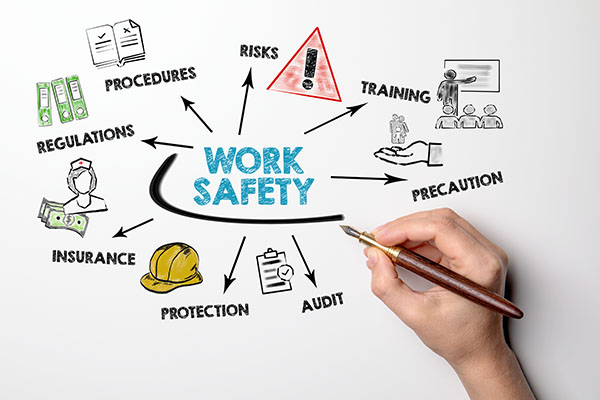Improved employee retention, less downtime for workers, fewer occupational health costs, satisfaction and productivity of employees, and reductions of retraining time are only a few reasons why WHS is so important for businesses.
 As a business owner/operator, you should always keep the safety of your employees pretty close to the top of your priority list.
As a business owner/operator, you should always keep the safety of your employees pretty close to the top of your priority list.
Most jobs involve carrying out some type of manual task using the body to move or hold an object, people or animals. Manual tasks cover a wide range of activities including stacking shelves, working on a conveyor line and entering data into a computer.
Some manual tasks are hazardous and may cause musculoskeletal disorders (MSD). These are the most common workplace injuries across Australia.
The terms ‘MSD’ refers to an injury to, or a disease of, the musculoskeletal system, whether occurring suddenly or over time.
No matter what field you are operating in, hazards and risks can always lie just around the corner. Unfortunately, it can be difficult to recognise these hazards until something goes wrong.
To prevent the injuries from happening, every business that prides itself on employee safety should have a WHS consultant come in on a semi-regular basis to monitor and check that your business is operating as smoothly and safely as possible.
To outline some of the expertise that a WHS consultant can offer, I’ll talk about some things you should know about WHS legislation for manual tasks.
Why is it important for business owners that employ workers to read and understand the Hazardous Manual Tasks Codes of Practice?
- It helps you get familiarised with the contents and guidance material in the said Code of Practice.
-
It relays the practical guidance on achieving the standards of WHS mandated in the WHS Act and the WHS Regulations.
-
It shares effective ways on how to identify the risks in fields.
-
It imparts practices on how to manage the potential hazards and risks to employees.
-
It helps you understand the safety laws for manual laborers, specifically the WHS Law.
-
It lets you know the impact the safety of the workers makes on the company.
-
It helps you strategise in maintaining productivity in your field, and it gives tips on how to observe safe systems.
What is the WHS Act?
The Work and Safety Act focuses on worker health and safety and applicable duties. It aims to protect the safety and health of all workers in any industry or field.
An overview of Australia’s WHS legal framework includes:
-
Work Health and Safety Act 2012 (SA)
The Act sets out the roles and duties as applicable for the PCBU, Officers, workers and others.
Develops and presents the requirements together with the standards every worker and employer alike to follow. It demonstrates and sets out guidelines on protecting every individual’s safety, health and safety in the workplace.
-
Work Health and Safety Regulation 2012 (SA)
This provides further information you need to adhere to for risk management – e.g., the process to identify, assess, eliminate or minimise risk, and review to ensure the controls are working as planned.
-
Codes of practice
Supporting the Act and Regulation gives logical and practical advice on how to meet their WHS responsibilities.
What is the Hazardous Manual Tasks Code of Practice?

This Code of Practice sets forth information on how to manage risks focusing on hazardous manual tasks. It further controls the risks of workers affected by musculoskeletal disorders (MSD).
This code of practice aims to guide the PCBU on how to handle or manage any health and safety risks associated with MSD due to hazardous manual tasks and is applied to their field, site, or company and places of work where these tasks are performed.
An approved code of practice provides practical guidance on how to achieve the standards of work health and safety required under the WHS Act and the Work Health and Safety Regulations (the WHS Regulations) and effective ways to identify and manage risks
Similar to regulations, this code of practice handles issues but may not cover all the incidents or risks in the workplace.
Codes of practice are admissible in court proceedings under the WHS Act and WHS Regulations. Courts may regard a code of practice as evidence of what is known about a hazard, risk, risk assessment or risk control and may rely on the code in determining what is reasonably practicable in the circumstances to which the code of practice relates.
Compliance with the WHS Act and WHS Regulations may be achieved by following another method if it provides an equivalent or higher standard of work health and safety than the code.
What is Hazardous Manual Handling and what are the risks?
Not all tasks are considered hazards. Hazardous manual handling pertains to the task wherein the employees are obliged to carry, move, lift, push, pull, restrain or hold an object.
These activities below are considered hazardous manual handling.
-
sustained uncomfortable posture or position
-
repetitive movements
-
handling animals or people
-
loads are unbalanced, unsteady, or hard to sustain
-
the force that needs to be repeated or maintained
-
prolonged exposure to vibration
Some of the most prominent risks for employees involved in Hazardous Manual Handling are; immediate injury due to improper training or an unsafe environment, and MSDs from prolonged exposure to Hazardous Manual Handling tasks.
What is an MSD?
MSD or musculoskeletal disorders are common recorded injuries for employees performing manual labor in Australia. This is a disease in the musculoskeletal system, which could be suffered by a worker immediately, randomly, or over a period of time.
Dissimilar to accidents such as crushing, cuts, burns, or entrapments caused by machines, MSD is commonly associated with internal injuries. This includes strains and strains of the muscles, injuries of the tendons and ligaments, wear and tear of muscles, damage of the spinal discs, joints or bones, degeneration of bones and joints in the elbow, wrists, hip, or shoulders—furthermore, compression or nerve injuries such as carpal tunnel syndrome.
MSD also includes muscular and vascular disorders resulting in hand-arm vibration. Employees experiencing MSD can also experience chronic pain such as hernias or other soft tissue injuries.
Musculoskeletal disorders are possible to be suffered in two different ways. These are:
-
wear and tear of ligaments, muscles, or vertebral discs due to continues or repeated usage of a specific body part, and
-
sudden or unexpected injury due to either strenuous activities, unprepared movements, for instance, moving and carrying loads of objects, or sudden change of position.
The combination of these two ways, is often a culprit to MSD.
How to Assess the Risks of MSD
 As a business owner, make it a habit to consult your workers and identify the hazards in the tasks they are carrying out or carry out. You should gather specific information about your workers about the MSD they encounter or experience.
As a business owner, make it a habit to consult your workers and identify the hazards in the tasks they are carrying out or carry out. You should gather specific information about your workers about the MSD they encounter or experience.
You may ask workers to name the tasks that are:
-
may seem easy but too difficult to complete
-
are causing muscle fatigue which reduces work capacity
-
requires to perform awkward positions
-
cause too much discomfort
Compensation claims, sick leaves, complaints, injuries, and inspection reports having MSD as a reason must also be taken into account to have further knowledge on the risks.
Trends also provide valuable information that may help you in deciding which manual handling tasks should be prioritized. Furthermore, observe your workers as apart from the activity itself, heat, lighting levels, heat, and other factors maximize the risk.
Stress-related to work, such as high job demands, poor support, and low job control, can also affect the development of MSD.
How to Control the Risk of MSD
The Work Health and Safety Regulations released a list to be followed in order. It’s pertained to the hierarchy of control.
-
Completely eliminate the risk by giving an alternative of the actions that cause the injury.
-
Change the work or the workplace. It could be the work systems, the layout, or the environment.
-
Train your workers, give them enough information and instructions.
Conclusion
If you are a business owner, you are expected to meet the requirements set in the code of practice as a minimum. You may use alternative methods such as technical or industry standards or anything equivalent or even higher to the requirements of the code.
First and foremost, seek consultation as soon as possible. Being one of the industries at risk across Australia, involving your workers in health and work issues results in a far safer and more harmonious workplace. They will give assistance and information regarding hazardous manual handling as not all manual tasks fall into the same category.
There are also situations where business owners must consult with Health and Safety Representatives (HSR) and workers towards a healthy and safe workplace.





